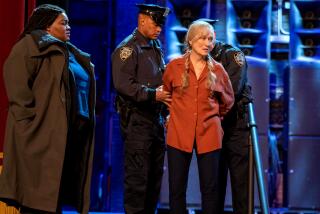‘Hope Springs’ review: Tommy Lee Jones, Meryl Streep keep it real
“Hope Springs,”starring Meryl Streep and Tommy Lee Jones, is an unusually intelligent cut at the relationship game. And considering the age of its stars, it’s a rarity for the movies, which tend to favor youth in all things.
This well-considered look at a long marriage that has lost its spark proves that old love is as fraught as any teenage crush and sex never fades as a source of contention. Darker and coming nearly a decade after Diane Keaton and Jack Nicholson’s middle-age flirtation in “Something’s Gotta Give,” Kay (Streep) and Arnold (Jones) are the conflicted couple. Their issue isn’t how to date at this stage in their life, but how to reclaim what has been lost after more than three decades together.
Their therapist, Dr. Bernard Feld (Steve Carell), is about to become the bridge over those troubled waters. The question is whether they can, or will, make it to the other side. For a change, it’s nice not knowing for sure how things will turn out.
Regardless of age, these sorts of love stories so often stray into sappiness. Refreshingly, David Frankel resists the temptation, directing his stars with a measured empathy that doesn’t allow the sap to seep in. Screenwriter Vanessa Taylor’s shrewd cultural take on an all too common, but little discussed, dilemma only adds to the film’s distinctiveness. On occasion the movie stumbles, and the couple momentarily lose their footing, but those are minor quibbles.
Indeed, these Oscar winners turn out to make a pretty terrific couple; certainly they are well-matched sparring partners. Arnold, an implacable and impatient number-crunching partner in an accounting firm, is a character that fits Jones as perfectly as his tailored suits and starched white shirts. Arnold is the flip side of the actor’s U.S. marshal in”The Fugitive,”just as implacable but instead of hot pursuit, he’s hiding out in his bunker, watching golf on TV.
In contrast, Kay is a homemaker who picks up pin money with a part-time job at a clothing store. She has spent a lifetime deferring and accommodating and is so unlike the strong women Streep typically plays, it is jarring at first. Streep creates a sense of unease and clings to it long enough that watching Kay at her weakest is almost unbearable. But it ultimately works for a film that is aiming at a certain level of discomfort.
“Hope Springs” has its share of comic moments, but the film opens on a downbeat. Kay is checking her hair in the bathroom mirror and adjusting a flowing nightgown that hints at her cleavage and curves. A few minutes later there’s a hesitant knock on Arnold’s bedroom door down the hall. A quick rebuff, and she’s back in her own bed — alone. That sense of isolation, as much as the loss of intimacy, shapes their marriage and sets the film’s bearing.
Frankel, who directed Streep in “The Devil Wears Prada,” is patient in building the various tensions necessary for us to begin to understand this particular marriage, milking small moments for a thousand small truths. Director of photography Florian Ballhaus, another “Prada” alum, keeps a keen eye on the details.
Typical is the couple’s morning routine. In it you can feel every one of their 31 years together. Kay is dressed and coiffed, apron on, cooking a slice of bacon and an egg just so. Arnold strides in, sits, and dispenses with the food and the morning paper in minutes. As he walks out the door he announces when he’ll be home. She lets him know what’s on tap for dinner. They do not touch; they barely make eye contact. It’s all very civil, very sad.
That détente is about to crumble as Kay’s unhappiness has reached a breaking point. A tentative first step at rebellion — picking up a marriage self-help book — becomes a line in the sand when she buys an intensive therapy package from its author, Dr. Feld. It entails a week of intensive couple’s counseling in a lovely coastal town in Maine appropriately named Great Hope Springs. Arnold resists until it sinks in just how out of character this is for his normally passive wife. If he were to look at his feelings, he might see fear, but he doesn’t.
Instead, Arnold goes to Maine with his wife, packing up his discontent and endless carping along with the vacation clothes. It takes a while, but on Dr. Feld’s couch, grievances emerge, wounds are opened, psyches are exposed. Sometimes it comes in sharply constructed dialogue. At other times it is all body language, Kay and Arnold’s positions on the couch speaking volumes. Carell has not been quite as effective at stripping his normally unflappable sensibility of any ironic undertones since he did so winningly in “The 40-Year-Old Virgin.”
When you are nearly as fed up with Arnold’s bombast as Kay is, the storm breaks and moves toward a possible reconciliation. This is where comedy starts to find its way into the film as they struggle to implement Dr. Feld’s “homework.” Something as simple as holding each other seems insurmountable; actual sex, unthinkable.
There are fantasies to consider fulfilling and logistics to figure out — a banana comes into play. Equal parts funny and poignant, the groping in “Hope” is as awkward and unsure as any you’d find in a coming-of-age romance, and in Jones and Streep’s fumbling hands, as believable.
More to Read
Only good movies
Get the Indie Focus newsletter, Mark Olsen's weekly guide to the world of cinema.
You may occasionally receive promotional content from the Los Angeles Times.











